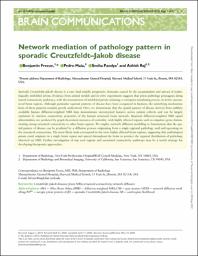
ATTENTION: The works hosted here are being migrated to a new repository that will consolidate resources, improve discoverability, and better show UTA's research impact on the global community. We will update authors as the migration progresses. Please see MavMatrix for more information.
Show simple item record
| dc.contributor.author | Freeze, Benjamin | |
| dc.contributor.author | Maia, Pedro | |
| dc.contributor.author | Pandya, Sneha | |
| dc.contributor.author | Raj, Ashish | |
| dc.date.accessioned | 2021-05-26T16:54:08Z | |
| dc.date.available | 2021-05-26T16:54:08Z | |
| dc.date.issued | 2020-05-15 | |
| dc.identifier.issn | 2632-1297 | |
| dc.identifier.uri | http://hdl.handle.net/10106/29732 | |
| dc.description.abstract | **Please note that the full text is embargoed** ABSTRACT: Sporadic Creutzfeldt–Jakob disease is a rare fatal rapidly progressive dementia caused by the accumulation and spread of pathologically misfolded prions. Evidence from animal models and in vitro experiments suggests that prion pathology propagates along neural connectivity pathways, with the transmission of misfolded prions initiating a corruptive templating process in newly encountered brain regions. Although particular regional patterns of disease have been recognized in humans, the underlying mechanistic basis of these patterns remains poorly understood. Here, we demonstrate that the spatial pattern of disease derived from publicly available human diffusion-weighted MRI data demonstrates stereotypical features across patient cohorts and can be largely explained by intrinsic connectivity properties of the human structural brain network. Regional diffusion-weighted MRI signal abnormalities are predicted by graph theoretical measures of centrality, with highly affected regions such as cingulate gyrus demonstrating strong structural connectivity to other brain regions. We employ network diffusion modelling to demonstrate that the spatial pattern of disease can be predicted by a diffusion process originating from a single regional pathology seed and operating on the structural connectome. The most likely seeds correspond to the most highly affected brain regions, suggesting that pathological prions could originate in a single brain region and spread throughout the brain to produce the regional distribution of pathology observed on MRI. Further investigation of top seed regions and associated connectivity pathways may be a useful strategy for developing therapeutic approaches. [This is a published version of an article published by Oxford University Press in Brain Communications on 15 May 2020, available online: https://doi.org/10.1093/braincomms/fcaa060.This article is available under the Creative Commons CC-BY-NC license (https://creativecommons.org/licenses/) and permits non-commercial use, distribution and reproduction in any medium, provided the original work is properly cited]. | en_US |
| dc.language.iso | en_US | en_US |
| dc.publisher | Oxford University Press | en_US |
| dc.relation.ispartofseries | Brain Communications;Volume 2, Issue 1 | |
| dc.subject | Creutzfeldt–Jakob disease | en_US |
| dc.subject | Prion | en_US |
| dc.subject | MRI | en_US |
| dc.subject | Structural connectivity | en_US |
| dc.subject | Network diffusion | en_US |
| dc.title | Network mediation of pathology pattern in sporadic Creutzfeldt–Jakob disease | en_US |
| dc.type | Article | en_US |
| dc.identifier.doi | 10.1093/braincomms/fcaa060 | |
Files in this item
- Name:
- network-mediation-of.pdf
- Size:
- 1.043Mb
- Format:
- PDF
- Description:
- PDF
This item appears in the following Collection(s)
Show simple item record


